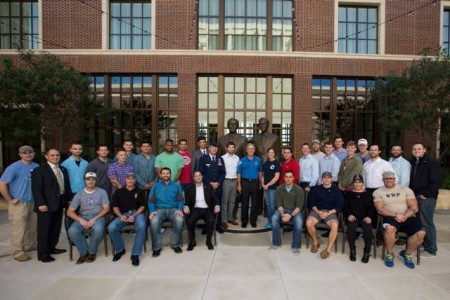
One day when walking into class, Brandon Montgomery noticed a student looking at him. The student did a double-take when his fully bearded classmate sat down.
Finally, he turned around asking Montgomery his age. That is when Montgomery knew he would be considered the old guy in his classes.
Like many student veterans at SMU, Montgomery, 30, is older than the typical college student. The SMU senior served in the United States Marine Corps for almost five years.
Coming to SMU for college is an adjustment for veterans.
They are adapting to civilian life along with getting an education.
“You kind of go from incredibly structured in everything you do. From waking up in the morning, to when you work out and eat, and all that stuff, to virtually no structure,” said Montgomery.
Montgomery is the president of the U.S. Military Veterans of SMU student organization.
The main purpose of U.S. MilVets is to help with the transition of veterans going from service to college life.
“It’s a transition because they are older, returning students,” said Rita Kirk, Meadows distinguished professor of communications and director of the Cary M. Maguire Center for Ethics and Public Responsibility. “They’ve had a different world experience and so there’s differences in the way that works. Some of them, not all of them, have issues that they have to deal with because of their time in service, some have post-traumatic stress disorder, PTSD and that affects them in various ways.”
SMU and U.S. MilVets seeks to provide a support system to the 108 undergraduate student veterans. Each year, the Maguire Center and the Office of the Provost hold a banquet to honor veterans in the SMU community.
“When I started working with the veterans five years [ago]… we had about 52 students,” said Veronica Decena, manager of certifications, transcripts, veteran affairs and imaging services at SMU. “We are definitely growing. The atmosphere is definitely growing in a more positive way.”
The transition begins the moment the veterans apply for the U.S. Department of Veteran Affairs educational benefits.
To receive benefits, students must complete a lot of paperwork. This can be a daunting task.
To make a college education affordable, SMU chose to participate in the Yellow Ribbon Program, an addendum to the Post-9/11 GI Bill. The scholarship program, a voluntary partnership with the Veteran’s Association (VA), pays for tuition of veterans who served on or after 9/11.
Currently, there are 45 SMU Yellow Ribbon recipients.
The Office of the University Registrar frequently keeps track of the progress of students receiving VA benefits. With the help of other offices on campus, like the Financial Aid Office and the Altshuler Learning Enhancement Center, the Registrar strives to make veterans have a successful college career.
“Their retention rate is excellent. Their graduation rate is pretty close to, almost at 100 percent,” Decena said.
Not only do veterans seek support from SMU staff, but also from their fellow classmates.
“Thank you to the support that we have received…Encourage them [students] to befriend a vet. We can sometimes kind of be aloof…but don’t hesitate to befriend us,” Montgomery said.
Kirk believes that SMU students and faculty can help with the transition of
student veterans.
To her, being respectful is a necessity due to the fact that less than 1 percent of the U.S. population serves in the military. According to a 2011 Pew Research Center Report, the percentage is 0.5.
“I think we need to be a little less critical about decisions that they made unless we are willing to put on the uniform ourselves,” Kirk said. “I think also as students just affirming that they have a different point of view, and not only letting them have that but letting them voice that and not feel like you are stifling them.”












